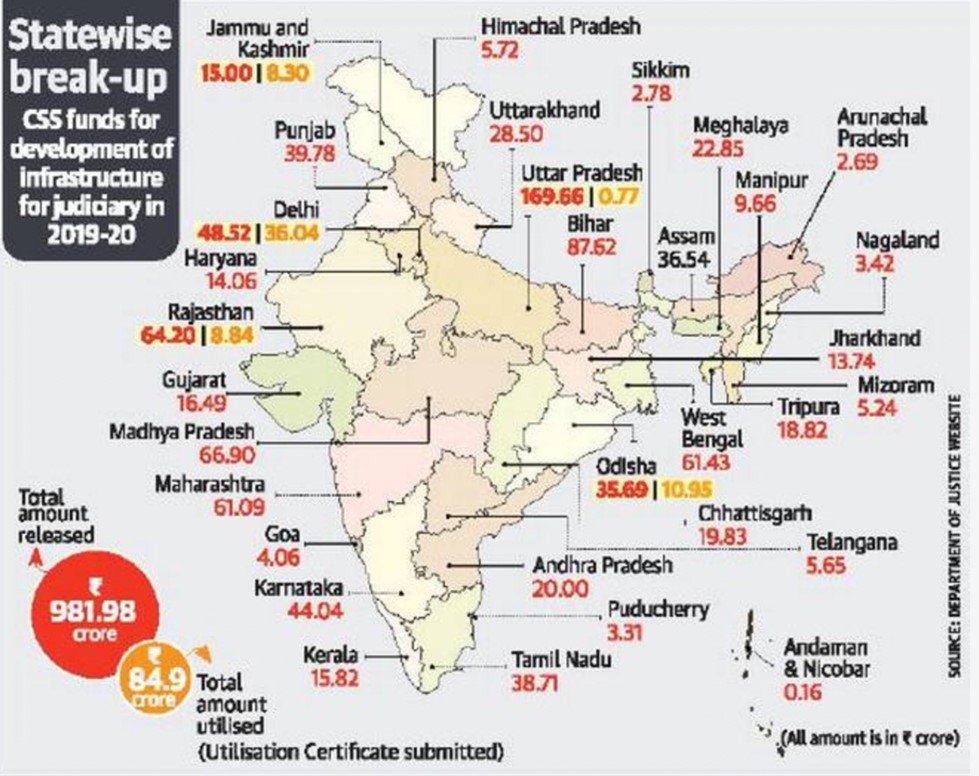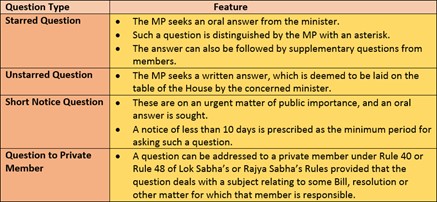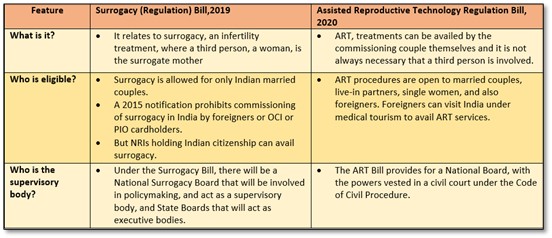Wednesday, 8th December 2021
The Armed Forces Special Powers Act (AFSPA), 1958
In News
The Nagaland government has called for repeal of the AFSPA in the wake of public outrage against the killings in Mon.
What is AFSPA?
- The Act in its original form was promulgated by the British in response to the Quit India movement in 1942. After Independence, amid the nascent Naga insurgency, India decided to retain the Act, in the form of the Armed Forces Special Powers Act (AFSPA), 1958.
- AFSPA has been used in areas where militancy has been prevalent. AFSPA has been imposed on the Northeast states, Jammu & Kashmir (J&K), and Punjab during the militancy years.
- Punjab was the first state from where it was repealed, followed by Tripura and Meghalaya. It remains in force in Mizoram, Nagaland, Manipur, Assam, J&K, and parts of Arunachal Pradesh.
- AFSPA provides for special powers for the armed forces that can be imposed by the Centre or the Governor of a state, on the state or parts of it, after it is declared “disturbed’’ under Section 3 of AFSPA.
- The Act defines these as areas that are “disturbed or dangerous condition that the use of armed forces in aid of the civil power is necessary’’.
How a region is declared ‘disturbed’?
- Section (3) of the AFSPA empowers the governor of the state or Union territory to issue an official notification in The Gazette of India, following which the Centre has the authority to send in armed forces for civilian aid.
- Once declared ‘disturbed’, the region has to maintain status quo for a minimum of three months, according to The Disturbed Areas (Special Courts) Act, 1976.
Powers under AFSPA that makes it draconian
- The Act, which has been called draconian, gives sweeping powers to the armed forces. It allows them to open fire, even causing death, against any person in contravention to the law or carrying arms and ammunition.
- It gives them powers to arrest individuals without warrants, on the basis of “reasonable suspicion”, and also search premises without warrants.
- The Act further provides blanket impunity to security personnel involved in such operations: There can be no prosecution or legal proceedings against them without the prior approval of the Centre.
Are there safety nets?
- While the Act gives powers to security forces to open fire, this cannot be done without prior warning given to the suspect.
- The Act further says that after any suspects apprehended by security forces should be handed over to the local police station within 24 hours.
- It says armed forces must act in cooperation with the district administration and not as an independent body. However, in the recent Mon operation, local law-enforcement agencies have said they were unaware of the operation.
What is state government’s role?
- The state governments can suggest whether the act is required to be enforced or not. But under Section (3) of the act, their opinion can be overruled by the governor or the Centre.
- While the Act empowers the Centre to unilaterally take a decision to impose AFSPA, this is usually done informally in consonance with the state government. The Centre can take a decision to repeal AFSPA after getting a recommendation from the state government.
Past attempts made to repeal AFSPA
- In 2000, Manipur activist Irom Sharmila began a hunger-strike, which would continue for 16 years, against AFSPA.
- The Justice Jeevan Reddy Commission on AFSPA in its report in 2005 said AFSPA had become a symbol of oppression and recommended its repeal. The Second Administrative Reforms Commission endorsed these recommendations.
Where can it be used?
- AFSPA, Internal Security
Sources:
Western Ghats fragility
In News: The Karnataka government has informed the Centre that the state is opposed to the Kasturirangan Committee report on Western Ghats.
Recommendations of the Kasturirangan committee report
- Eco-sensitive Area: The report proposes 37% of the total area of Western Ghats to be declared as eco-sensitive area (ESA). Out of this, 46.50% of total area falls in Karnataka.
- Blanket ban on activities: It recommended a blanket ban on mining, quarrying, setting up of red category industries and thermal power projects.
- Impact of infrastructural projects on the forest and wildlife should be studied before permission is given for these activities.
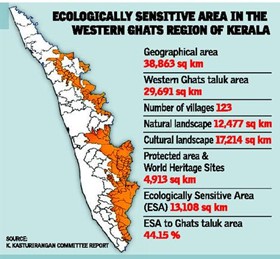
- Importance of its Heritage tag: The committee stated that the UNESCO Heritage tag for the Western Ghats is an opportunity to build global and domestic recognition of the enormous natural wealth that exists here.
- The 39 sites are located across the Western Ghats and distributed across the states of (Kerala 19), Karnataka (10), Tamil Nadu (6) and Maharashtra (4).
- The boundary of the sites, are in most cases, boundaries of the legally demarcated national parks, wildlife sanctuaries, tiger reserves and forest divisions and therefore, already accorded with high level of protection.
- The Eco-Sensitive Area mapping and demarcation done by the committee indicates that all sites are within this area.
- Role that the Government should play: The state governments should build a plan to protect, conserve and value the resources and opportunities of the region.
Reasons for the State’s Opposition
- Adverse Impact on the livelihood of the people: The state expressed that declaring Western Ghats as ecologically sensitive zone would adversely affect the livelihood of people in the region as it prohibits certain activities.
- Disruption in Developmental activities: The state government believes that implementation of the report will halt the developmental activities in the region.
- Different Ground reality: It is stated that people of the region have adopted agriculture and horticultural activities in an eco-friendly manner and that priority has been accorded for environment protection under the Forest Protection Act.
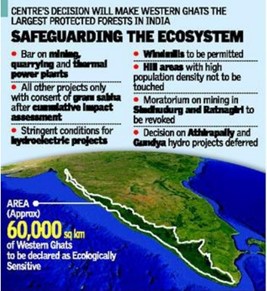
Conclusion: The popular view is that considering the changes in climate (evident from recurring floods, droughts, landslides, increasing temperature, etc), which would affect the livelihood of all people (irrespective of poor or rich) and hurt the nation’s economy, it is prudent to conserve the fragile ecosystems that costs less compared to the situation prone to calamities (with changes in the climate) than spending money /resources for restoration and rejuvenation.
Where can it be used?
- Western Ghats, Ecology, Kasturirangan Committee
Source:
- Explained: Why implementation of the recommendations of Kasturirangan Committee in Western Ghats is important
- Karnataka again rejects Kasturirangan report on Western Ghats
- Karnataka govt rejects Kasturirangan report on Western Ghats, plans to approach SC
Image Source:
Law of Succession
Supreme Court has observed that the Hindu Succession Act is discriminatory against women in matters of property succession and has asked the solicitor general to provide the Centre's views on it.
Laws of succession in India
- The law of succession defines the rules of devolution of property in case a person dies without making a Will. These rules provide for a category of persons and percentage of property that will devolve on each of such persons.
- Corporate persons having perpetual existence are not covered in this and have separate laws relating to Winding up, Reorganization and Closure.
- The laws of succession can broadly be divided in two parts:
- In case there is no will:
- The Indian Succession Act 1925 (the Indian Succession Act) governs succession among Parsees, Jews and Christians.
- Hindu Succession Act 1956 governs succession matters of Hindus, Sikhs, Buddhists and Jains.
- Succession among Muslims is governed by uncodified shariah law.
- In case there is a will or testamentary disposition: The provisions of the Indian Succession Act are applicable to everyone, except Muslims, regardless of the religion being followed. The testator can thereby bequeath his or her property in any manner that he or she desires.
- In case there is no will:
Major provisions of Hindu Succession Act, 1956
- It governs laws regarding the succession of husband's property as well as father’s property.
- It allows a Hindu female to become an absolute owner of property.
- Female could inherit equally with a male counterpart.
- The Hindu Succession (Amendment) Act, 2005 made the daughter, like son, a coparcener in a joint family.
Issues with the Hindu Succession Act
Glaring inequality in property succession as provided under the Act:
- On the death of an issueless Hindu married male, his properties would vest with his parents.
- In case of the death of an issueless widow, her properties, excluding those inherited by her from her parents, will vest not with her parents, but with her husband's parents or relatives even if the properties were gifted to her by her parents or blood relatives.
- Whether the property is inherited from the father or mother, in both the cases, the devolution will be upon the 'heirs of the father' in case of the death of a childless widow.

Sources:
Tej Bahadur Sapru
On December 8, 1875 Sir Tej Bahadur Sapru was born in Aligarh. He was an Indian freedom fighter and eminent lawyer. As representative of Liberal party, he participated in RTC. He defended captured soldiers of the Indian National Army. He established the Indian Council of World Affairs (1943). As early as 1927, Sapru organized an All Party Conference to begin drafting the Indian Constitution. In 1928, he helped draft the Nehru Committee Report on Constitutional Reforms. Sapru served in the Legislative Council of the United Provinces (1913–16) and the Imperial Legislative Council (1916–20) and as a member for law affairs in the Viceroy's Council (1920–23).

Source:
Dam safety in India
In News: The Dam Safety Bill 2019 has been passed by both the houses and it is expected to begin a new era of dam safety & water resources management in India.
Need for Large Dams
- Dams are used to store water in reservoirs throughout the year amid highly variable seasonal flow of rivers in a country like India.
- Water available through these reservoirs are utilised for drinking purposes, irrigation for agricultural operations, Hydro Power generation etc.
- Reservoirs also support Inland Navigation.
- Dams mitigate flooding in downstream areas of the river flow.

Deteriorating health of Large Dams
- After China and USA, India is the 3rd largest dam-owning nation in the world. There are around 5,700 large dams in the country, of which about 80% are already over 25 years old. Nearly 227 dams that are over 100 years old are still functional. For e.g., The Mullaperiyar dam, built in 1895 on the Periyar river in Idukki district of Kerala.
- According to the Central Water Commission (CWC), the ageing of dam assets warrants serious concern on their safety aspects in terms of meeting prevalent norms..
- Some 40 dams have collapsed in India since Independence. One of the worst disasters took place in Gujarat in 1979 when the Machhu dam collapsed resulting in the loss of thousands of lives.
- Climate change related extreme weather events, especially floods, are expected to accelerate a dam's ageing process, especially where large dams were designed using historical hydrological data or do not meet present day design standards structurally.
- Reservoir sedimentation affects the safety of dams and, without proper management, negatively impact the environment.
- Although, not all dam failures can be attributed to ageing of the structure, the commonly cited triggers of failures, i.e., structural flaws, extreme floods, landslides, internal erosion, are more likely in older dams because ageing increases the vulnerability of a dam to such triggers.
Existing Dam safety regulations in India
- In India, the Central Dam Safety Organisation, under the Central Water Commission (CWC), provides technical assistance to the Dam Owners, and maintains data on Dams.
- The National Committee on Dam Safety, devises Dam Safety Policies and Regulations.
- Several States and Public Sector Undertakings (PSUs) that own dams in the country, set up their own Dam Safety Organisations (DSOs), and have taken up measures for ensuring dam safety in their respective jurisdictions.
- Currently, 18 States and some autonomous bodies such as Damodar Valley Corporation or Bhakra Beas Management Board of Bhakra-Nangal Project have their own Dam Safety Organizations.
- In the absence of a Central Law, however, the safety regulations vary from state to state.
Other measures on Dam safety
- At the international level, the International Commission on Large Dams (ICOLD), a Non-Governmental Organization, provides a forum for the exchange of knowledge and experience in dam engineering. The Committee for International Commission on Large Dams, (INCOLD) is the Indian Committee interacting with ICOLD Central Office in Paris.
- Government of India, with aid from the World Bank initiated Dam Rehabilitation and Improvement Project (DRIP) in April 2012 with an objective to improve the safety and operational performance of selected existing dams along with dam safety institutional strengthening with system wide management approach. Phase I of the scheme has been completed and DRIP Phase II and Phase III was approved recently for 10 years.
- National Hydrology Project (NHP), a Central Sector Scheme has made significant progress in the fields of Water resource monitoring system, water resource information system (WRIS), water resource operation and planning systems and institutional capacity enhancement.
Provisions of the Dam Safety Bill, 2019
- The Bill covers the dams constructed before or after the commencement of this Act, having the height of over 15 metres and between 10 and 15 metres with certain stipulations.
- The Bill provides for an institutional mechanism at both Central and State levels. To ensure dam safety, there will be four layers of monitoring, two at the central level and two at the state level.
- A National Committee on Dam Safety (NCDS), headed by the chairman of Central Water Commission (CWC) and representatives of central and state governments, will be constituted to help evolve uniform dam safety policies, protocols, and procedures.
- The Bill also provides for the establishment of a National Dam Safety Authority (NDSA) as a regulatory body for nationwide implementation of dam safety policies and standards.
- This Bill provides for regular inspection and hazard classification of dams. It also provides for drawing up of emergency action plans and comprehensive dam safety reviews by an independent panel of experts.
- There is provision for an emergency flood warning system to address the safety concerns of downstream inhabitants.
- This Bill has penal provisions, involving offences and penalties, for ensuring compliance of the provisions.
Issues with the Bill
- Constitutional validity: Water falls under the State List of the Seventh Schedule of the Constitution. The Centre has brought the legislation under Article 246 of the Constitution read in the Union list. Article 246 empowers Parliament to legislate on any matter enumerated in List I of the Union list.
- This circumvention has left many sceptics questioning the validity of the legislation.
- Payment of compensation: The bill does not include any clause on the payment of compensation to people affected by dam projects
- Losing control over old dams: Many States, including Karnataka, Kerala, Tamil Nadu and Odisha, have opposed the Bill because they say it encroaches upon the sovereignty of States to manage their dams, and violates the principles of federalism enshrined in the Constitution.
Way Forward
- Dam Safety Bill: The Centre can hold talks with the States to allay their fears and frame rules suitably for the legislation.
- Decommissioning of Dams: To avert the catastrophic consequences of ageing dams, international practices like decommissioning should be utilised. Decommissioning or removal, partially or entirely, is less costly than repairing or rebuilding.
- Still, it is a time-consuming process that requires continuous expertise, and public involvement and is often subject to lengthy regulatory approvals. India may bring regulations in this regard.
- Rethinking new projects: Some of the Himalayan dam systems, including the Tehri Dam, are in an active seismic area. They pose immediate threat to people living downstream of the dam. Also, the recent Rishiganga disaster provides an insight into the dangers that large dams pose in such areas. Yet, many new projects are coming up in the Himalayan areas which should be reanalysed.
- Forum to voice the concerns of people: There may be constituted management committees for every dam, where fully independent voices of experts, other than the government agencies, as well as, those representing the vulnerable downstream communities will have a say in the dam safety policy paradigm.
Question: Discuss the need for dam safety in India. How does the Dam Safety Bill, 2019 try to address these issues?
Where can it be used?
- Dam safety, Infrastructure
Sources:
- Explained | What is the debate on the Dam Safety Bill?
- Explained: The Dam Safety Bill, and why Tamil Nadu is against it
- Ageing-Water-Storage-Infrastructure-An-Emerging-Global-Risk
- Rajya Sabha Passes The Landmark ‘Dam Safety Bill (2019)’
- DAM REHABILITATION AND IMPROVEMENT PROGRAMME
- Union Minister of Jal Shakti reviews progress made under National Hydrology Project in its mid-term
Mysterious' object
This is image of a mysterious' object spotted by Chinese Yutu 2 rover on far side of the Moon. The object has been referred to as a "mystery house" and in the next two to three lunar days, the rover will attempt to get closer and check it out. It is understood that the object spotted by Yutu 2 is not an obelisk or aliens as it can be boulders, which are usually formed by impacts of landings. Yutu 2 was was launched on December 2018 and it entered lunar orbit on December 2018. It made the first soft landing on the Moon's far side on January 3 in 2019. Yutu-2 is currently operational as the first lunar rover on the far side.

Sources:
Greater Tipraland
- Context: Several tribal groups in Tripura have come together demanding a separate state- Greater Tipraland, for the indigenous communities of the north-eastern state.
- They want the Centre to carve out the separate state under Article 2 and 3 of the Constitution.
- As per Article 2 of the Constitution, Parliament may by law can admit into the Union, or establish, new States on conditions as it thinks fit.
- However, Parliament cannot establish a new union territory by passing a law, which can only be done through a constitutional amendment.
- Article 3 empowers the Parliament to make law relating to the formation of new states and alteration of areas, boundaries or names of existing States.
- The demand mainly stems from the anxiety of the indigenous communities due to the change in the demographics of the state, which has reduced them to a minority (from 63.77% in 1881, their population had come down to 31.80% by 2011) due to the displacement of Bengalis from the erstwhile East Pakistan between 1947 and 1971.
- Among the 19 notified Scheduled Tribes in Tripura, Tripuris (aka Tipra and Tiprasas) are the largest. According to the 2011 census, there are at least 5.92 lakh Tripuris in the state, followed by Reangs (1.88 lakh) and Jamatias (83,000).

Source:
Image Source:
Statutory Bail
- Context: The National Investigation Agency (NIA) has approached the Supreme Court against a Bombay High Court order granting bail to an activist.
- Default bail, also known as statutory bail, is a right to bail that accrues when the police fail to complete investigation within a specified period in respect of a person in judicial custody.
- This is enshrined in Section 167(2) of the Criminal Procedure Code where it is not possible for the police to complete an investigation in 24 hours, the police produce the suspect in court and seek orders for either police custody or judicial custody.
- The police have 60 days to complete the investigation and file a final report before the court for most offences.
- However it is 90 days where the offence attracts death sentence or life imprisonment, or a jail term of not less than 10 years.
- In other words, a magistrate cannot authorise a person’s judicial remand beyond the 60-or 90-day limit.
- At the end of this period, if the investigation is not complete, the court shall release the person “if he is prepared to and does furnish bail”.

Source:
- Explained | When can an individual get statutory bail?
- Elgar case: Supreme Court rejects NIA's plea against default bail to Sudha Bharadwaj
Image Source:
World’s First Fully Solar Powered Airport
- Context: Kochi Airport becomes the first in the world to be fully solar-powered.
- Kerala’s Cochin International Airport Ltd (CIAL) is the first private airport in the country and the first airport in the world to run fully on solar power.
- CIAL has commissioned one of the biggest floating solar power plants in the state with a capacity of 452-kilowatt hour (KWh).
- The floating solar plants were installed in two artificial lakes using French technology which mounted 1300 photovoltaic panels for the best cost effective power generation.
- The airport officially commissioned a 12 MW solar project in 2015.
- CIAL was the first airport to be constructed in public-private-partnership model in the country and has been into operation for 16 years and is also the only airport company that has handled more than five million passengers in a year in Kerala.

Source:
- Anand Mahindra posts pictures of Kochi Airport,first in the world to be fully solar-powered
- Kochi Airport, World's First To Fully Run On Solar Power, Now Adds A New Floating Solar Plant
Image Source:
Public Accounts Committee
- Context: Public Accounts Committee has marked its 100th year
- After its first mention in the GOI Act, 1919 (Montague Chelmsford Reforms) the Public Accounts Committee was introduced in 1921.
- It is constituted by Parliament each year for examination of accounts showing the appropriation of sums granted by Parliament for expenditure of Government of India, the annual Finance Accounts of Government of India, and other such accounts laid before Parliament under Rule 308 of the Rules of Procedure and Conduct of Business in Lok Sabha.
- The Committee consists of 22 Members, 15 Members are elected by Lok Sabha and 7 Members elected by the Rajya Sabha with a term of only one year.
- The Chairman of the Committee is appointed by the Speaker of the Lok Sabha.
- The committee’s decisions are advisory by nature as it is not an executive body
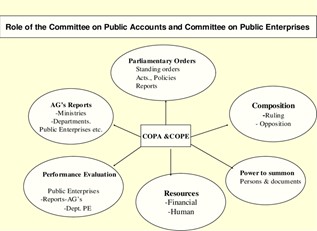
Source:
- 100 years of Public Accounts Committee: Venkaiah Naidu calls for debate on freebies, Om Birla notes importance of House panels
- Committee of Public Accounts
Image Source:
What schools need to do during pandemic?: IE
Essence: Students have resumed offline classes, even as the pandemic is not fading away any soon. Omicron, the new variant, may emerge as a major epidemiological concern for schools. Having said that, the good thing is that symptomatic disease in children is much less and incidence of severe disease requiring hospitalization and cases of deaths are rare. Also, staying at home has not prevented children from getting exposed to SARS- CoV-2. Moreover, primary school children have the least risk of severe disease.
The writers of the article link the outbreak of COVID in schools with 3 C’s – closed spaces, crowded space, close contacts. Schools’ administration has a responsibility to follow the detailed advisories already issued to them. Decisions of closure or reopening of schools should be taken at the local administration (WHO). What is important is to realize that children must live in a vaccine protected environment even if they themselves are not immunized. Parents should not wait for the pediatric vaccination and send their children to schools for their overall development. Schools are extremely important for the socialization of children.
Why to read this article?
- To understand that relevance of offline education for children amid the COVID pandemic and what are the steps the school administration should take in this regard.
- The article becomes important not only from the perspective of GS II- Education and Vulnerable Section (Children) but also for Case Study (GS IV).
Source:
Onshoring fabrication is a precondition to secure Indian techno-sovereignty: ORF
Essence: The article highlights the increased significance of digital ecosystem in providing various financial, health, education, communication, entertainment, and governance services. India has the huge advantage of providing digital public goods through India Stack but needs to depend on imports for next gen digital revolution. This challenges the techno-sovereignty of the country and challenges cyber-security protocols, communication networks, cloud and data centres.
Initiatives to ban 200 Chinese mobile apps, procurement from verified sources, etc are steps in the right direction. Since India has been at the cusp of a digital revolution, there has been an accelerated demand for electronic goods. Instead of imports, this demand of digital hardware could be met through domestic sourcing. It provides India the strategic entry into semiconductor industry- from becoming a sub-assembly hub to full-stack manufacturing. Eg. consumer, industrial, and strategic electronics, computer hardware, mobile phones, components, and LEDs.
For this to happen, India needs to invest in intellectual property and RnD of semiconductor manufacturing. It will enable India to become self-dependent in upstream and downstream industries alongside creation of jobs and offering specialties to the World.
Why you should read this article?
- To understand the need for India to secure indigenization of semiconductor industry.
- To update oneself with various initiatives taken to promote Make in India with respect to digital goods.
Source:
Being free of old waste: TH
Essence: The article applauds the recently launched Swach Bharat Mission (SBM) 2.0 guidelines that goes an extra mile to tackle the problem of solid waste management. The guidelines 2.0 provides for processing of all types of wastes along with providing budgetary support for remediating old waste whereas the earlier one provided for mere collection and transportation of waste.
Urban Local Bodies in several states made detail plans for setting up waste processing system but couldn’t get executed due to lack of funding. A funding of 1.41 crores has been dedicated for implementing solid waste management under 2.0 will have two-fold effect. First it will help government in achieving the target of waste disposal sites free from old waste by 2023. Second the organic compost recovered from wet waste could be used as chemical fertilizers, hence reducing India’s dependence on imports.
Why you should read this article?
- To understand the provision provided under Swach Bharat Mission 2.0 .
- To understand the role of bioremediation in tackling the solid waste.
Source:
Revival of Himalayan Spring by the efforts of an IFS officer
Background
- Erratic rainfall has led to loss of perennial springs in the Himalayan region, leading to loss of income and migration of the locals.
- Efforts of an IFS Officer Dharam Singh Meena led to the revival of 66 Himalayan springs, helping 23 villages in Uttarakhand’s Tehri Garhwal region.
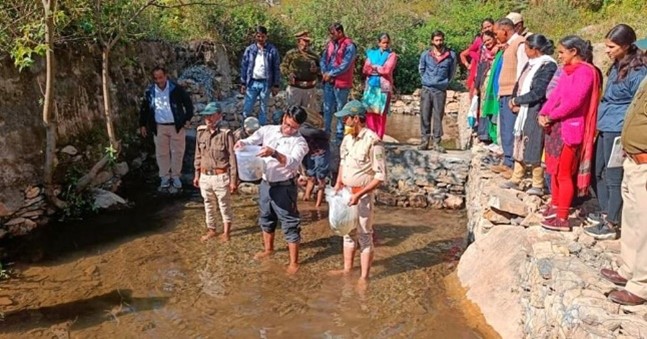
Revival of the Himalayan spring ecosystem
- The recent changes in land use patterns due to rampant development over the Garhwal region has affected the hydrogeology of the springs.
- Lack of requisite amount of water in the Heval river led to deterioration for the quality of fruits and vegetables.
- IFS Officer Dharam Singh Meena noticed the changes around the area and started working on plans for the revival of these springs.
- He relied on scientific methods of conservation and revival and also took the help of NGOs.
- Villagers were requested to pool in the monetary investment and human resources for restoration work.
- Eventually, the efforts bore the fruit and led to recharge of groundwater and revival of 66 springs.
Quote:
When we reconnect with nature, we will recover – restore ecosystem.
Source:
Share the article
Get Latest Updates on Offers, Event dates, and free Mentorship sessions.

Get in touch with our Expert Academic Counsellors 👋
FAQs
UPSC Daily Current Affairs focuses on learning current events on a daily basis. An aspirant needs to study regular and updated information about current events, news, and relevant topics that are important for UPSC aspirants. It covers national and international affairs, government policies, socio-economic issues, science and technology advancements, and more.
UPSC Daily Current Affairs provides aspirants with a concise and comprehensive overview of the latest happenings and developments across various fields. It helps aspirants stay updated with current affairs and provides them with valuable insights and analysis, which are essential for answering questions in the UPSC examinations. It enhances their knowledge, analytical skills, and ability to connect current affairs with the UPSC syllabus.
UPSC Daily Current Affairs covers a wide range of topics, including politics, economics, science and technology, environment, social issues, governance, international relations, and more. It offers news summaries, in-depth analyses, editorials, opinion pieces, and relevant study materials. It also provides practice questions and quizzes to help aspirants test their understanding of current affairs.
Edukemy's UPSC Daily Current Affairs can be accessed through:
- UPSC Daily Current Affairs can be accessed through Current Affairs tab at the top of the Main Page of Edukemy.
- Edukemy Mobile app: The Daily Current Affairs can also be access through Edukemy Mobile App.
- Social media: Follow Edukemy’s official social media accounts or pages that provide UPSC Daily Current Affairs updates, including Facebook, Twitter, or Telegram channels.

